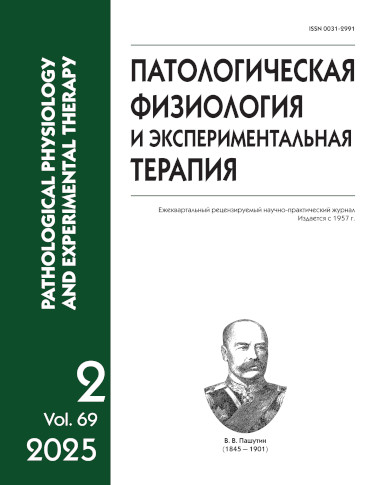Прогностические маркеры течения бруцеллёзной инфекции
DOI:
https://doi.org/10.48612/pfiet/0031-2991.2025.02.85-91Ключевые слова:
бруцеллёз, маркеры гемостаза, антикоагулянтыАннотация
Введение. Анализ научной литературы показал, что нарушения в системе гемостаза при бруцеллёзе развиваются вследствие системного характера инфекции и приводят к эндотелиальной дисфункции. Состояние гемостатической системы организма при бруцеллёзной инфекции остаётся практически не изученными, что создаёт предпосылки для дальнейшего исследования. Выявление диагностических маркеров может способствовать оценке прогноза течения и раннему выявлению риска развития сосудистых осложнений. Цель исследования – определение маркеров антикоагулянтной системы гемостаза и значения васкулоэндотелиального фактора в оценке прогноза течения бруцеллёза. Методика. Объект исследования – больные с диагнозом «острый бруцеллёз», (n=78), поступившие в бруцеллёзное отделение ГКБ №2 г. Ставрополя, и инфекционную больницу Республики Дагестан. Материалом для исследования служила сыворотка/плазма крови больных острым бруцеллёзом. В контрольную группу были включены 34 человека, не переболевших бруцеллёзом и не вакцинированных против этой инфекции. Анализ уровня антитромбина III в плазме крови проводили хромогенным методом; определение концентрации протеина С выполнено оптическим методом с применением фотометра; на автоматическом анализаторе проведено исследование концентрации фибриногена, ортофенантролиновым тестом проведена оценка растворимых фибрин-мономерных комплексов (РФМК), концентрацию васкулоэндотелиального фактора (VEGF) определяли методом твердофазного иммуноферментного анализа (ИФА). Результаты. В острую фазу заболевания у больных острым бруцеллёзом отмечалось снижение уровня первичных антикоагулянтов в плазме крови (антитромбина III, протеина С), повышение фибриногена, и как следствие, увеличение концентрации вторичного антикоагулянта (растворимых фибрин-мономерных комплексов) относительно данных контрольной группы. Выявлено увеличение концентрации эндотелиального маркера – васкулоэндотелиального фактора. Заключение. Длительная персистенция бруцелл приводит к достаточно продолжительному, однако не выраженному воспалению, обусловливая развитие защитно-приспособительной реакции, направленной на поддержание системы гемостаза. Исследуемые показатели (антитромбин III, протеин С, фибриноген, РФМК, VEGF), являются диагностически значимыми в оценке прогноза течения бруцеллёзной инфекции.Загрузки
Опубликован
2025-06-09
Выпуск
Раздел
Оригинальные исследования
Как цитировать
[1]
2025. Прогностические маркеры течения бруцеллёзной инфекции. Патологическая физиология и экспериментальная терапия. 69, 2 (Jun. 2025), 85–91. DOI:https://doi.org/10.48612/pfiet/0031-2991.2025.02.85-91.













